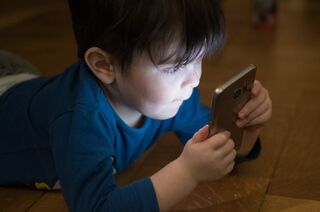Media
Digital Distractions: Energy Drain and Your Brain on Screens
We bond on media platforms that make outrage and indignation infectious.
Posted October 27, 2020

The coronavirus has chained us to our screens more than ever before and confirmed how hard it is to wrest digital devices away from kids—of every age. For adults working from home, staring into screens has confirmed the suspicion that what was once a servant is now the master.
Pandora’s box will neither close nor go away. Rather than recommend blocking apps, which users circumvent anyway, or paid apps that promise to limit your time online, what if we empowered people to swat distractions aside and ignore them? Many screen devotees claim to be addicted. But this is not through any fault of their own, as the tech titans explain in the Netflix documentary, The Social Dilemma. Online algorithms driven by enormous financial incentives goad users into ever more engagement and commandeer the brain’s fixed bandwidth.
For all the benefits that smart devices bring, they are also narcotizing agents. The smartphone magic that puts the world in our hand can quickly become malevolent and, as the sorcerer’s apprentice discovered, beyond our ability to control. Corporations know that there are only 1,440 minutes in a day, and they compete ruthlessly for our attention. They hack our neurological defenses so easily that they don’t need to hide their agenda.
I look at the neurological consequences of screen distractions, and the distractions themselves, in a fresh way—from the brain’s perspective. In particular, how much energy does the daily torrent of texts, alerts, and push notifications exact from our finite stock? The physical, mental, and emotional costs of digital distractions have largely gone unexamined. So has the nonchalance with which we shove screens in front of a child’s developing central vision while ignoring the way that iPads mounted in bassinettes, car seats, and potty trainers displace human interaction to the potential detriment of learning how to socialize.
Biologically, we still have essentially the same brain as our ancient ancestors. Brain circuits operate at dramatically lower speeds compared to their electronic counterparts and within a limited bandwidth of available energy. All you can affect is how you manage it, and how you do that determines your mental efficiency. We all face the same quandary our distant ancestors did of how to marshal and apportion the energy needed for thinking, acting, feeling, imagining, anticipating, and most of all paying attention.
The brain accounts for only 2 percent of body mass, yet its 86 billion neurons burn 20 percent of the daily calories we ingest (see my short TED lesson, “What Percentage of Your Brain Do You Use?”). The adolescent brain burns 50 percent, infants and growing youngsters 60 percent, which is why the young may suffer most from heavy screen engagement. No matter what one’s age, the costliest things we can do in terms of energy expenditure are shift, focus, and sustain attention—a cycle that digital devices force us to repeat endlessly as if circling a drain.

The brain achieves its amazing feats using an amount of energy equivalent to that of a dim light bulb. Most of it goes toward maintaining the physical structure with little left over for thought, feeling, and action. Precisely because it is so efficient, its reserve margins are slim and quickly eaten up by the demands made by constantly shifting attention. Think in terms of a budget whose currency is all the molecules that maintain our 86 billion neurons. As with monetary budgets, we can run a metabolic deficit and go into the red. When this happens the brain terminates processes that are “too expensive,” resulting in mental fatigue, reduced focus, patchy memory, and error. Even the “mere presence” of a phone drains us because resisting the temptation to look takes effort and thus energy. It can reduce cognitive capacity and focus.
What matters more than having 86 billion brain cells is the dynamic weaving and constant rewiring of connections among them, a lifelong process known as “plasticity” that makes the living, electrified fabric of a unique individual and a unique mind. From birth onwards the brain constantly absorbs experience, good and bad, plastically changing both the organ’s structure and function. The 21st-century mindset is now one trapped in the immediate present, in need of constant external stimulation.
The incessant, seductive presence of screens promotes sensation at the expense of thought, the amped-up pathways competing with the maturation of circuits normally destined to support social relationships and emotional intelligence. Screen exposure in early life, then, may have serious implications.
We live in a paradox in which digital tech alleviates social isolation in some ways even as it worsens it in others. It may be fashioning wholly new brain pathways for good or ill in ways we neither notice nor can predict. While we are technically more connected to one another than ever before, we bond on media platforms engineered to make outrage and indignation infectious. They exploit the psychological principle that emotion, like yawning, is highly contagious.
The digital deluge allows for neither nuance nor complexity. Its overstimulation can overwhelm critical thinking, making it difficult to weigh the torrent of information coming at us and leaving us open to propaganda. According to longtime Silicon Valley backer Roger McNamee, Russia didn’t hack Facebook to sway U.S. elections: It simply used the platform to its advantage.
Two buzzwords in education circles are “critical thinking” and an ability to “connect the dots.” But the internet encourages shallow surfing, while offloading factoids to external repositories such as Google may leave us with a paltry storehouse of shared knowledge and fewer dots to connect. A mind capable of these things thrives on quiet, not push notifications. The natural world is easy on the eyes and ears, yet we cut ourselves off from its restorative balm and forget that the brain, the psyche, and the soul all need rest. They need interludes of uninterrupted time rather than streaks, banners, badges, auto-play, and screen engagement that can drive friendships and achievements into bloodthirsty competitions.
In addition to disrupting the natural sleep cycle, late-night screen viewing has unintended physical consequences that stem from the bright shortwave light that blasts from TVs, tablets, laptops, and smartphones. Compared to adults, the teenage circadian clock is twice as sensitive to this short-wavelength light. They now wake up in the middle of the night to check their phones and social media. But even a few seconds of screen light then undermines the benefits of switching off and turning in at a decent hour.
The Latin word addictum originally described the length of time an indentured slave, or addict, had to serve their master. The word’s root means “bound to.” And are we not bound like slaves to the screen in our hands? If not, then why else do so many people claim to be addicted?
Please send comments via the Author Profile, where you can also ask Dr. Cytowic for articles and papers, including “Your Brain on Screens.”
References
Eagleman, D., Livewired: the inside story of the ever-changing brain. 2020, Pantheon Books, New York.
Robb, D., The New Normal: Parents, Teens, Screens, and Sleep in the United States. 2019, San Francisco: Common Sense Media
Roger McNamee speaking in "The Social Dilemma" documentary on Netflix, 9/11/20. The longtime Silicon Valley backer turned into one of its fiercest critics.




